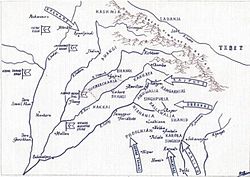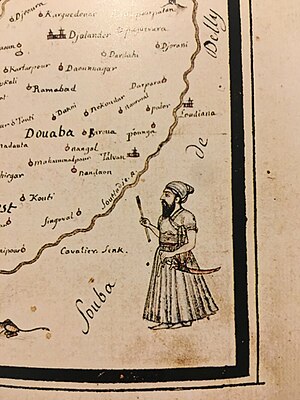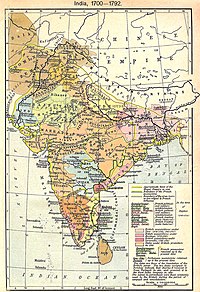Sikh Confederacy
Sikh Confederacy Sikh Misalā | |||||||||||||
|---|---|---|---|---|---|---|---|---|---|---|---|---|---|
| 1748–1799 | |||||||||||||
| Motto:ਅਕਾਲ ਸਹਾਇ Akāl Sahāi "With God's Grace" | |||||||||||||
| Anthem:ਦੇਗ ਤੇਗ ਫ਼ਤਿਹ Dēg Tēg Fateh "Victory to Charity and Arms" | |||||||||||||
 Map of the Sikh Confederacy (1782) | |||||||||||||
| Status | Confederation | ||||||||||||
| Capital | Amritsar | ||||||||||||
| Language | Punjabi | ||||||||||||
| Religion | Sikhism(official) | ||||||||||||
| Government | Aristocraticrepublics[1] | ||||||||||||
| Jathedar | |||||||||||||
• 1748–1753 | Nawab Kapur Singh | ||||||||||||
• 1753–1783 | Jassa Singh Ahluwalia | ||||||||||||
• 1783–1799 | Naina Singh | ||||||||||||
| Legislature | Sarbat Khalsa | ||||||||||||
| History | |||||||||||||
• Passing ofGurmatato establish the Sikh Confederacy | 29 March 1748 | ||||||||||||
•Ranjit Singhunites the Sikh Confederacy into the Sikh Empire | 7 July 1799 | ||||||||||||
| Currency | Nanakshahi | ||||||||||||
| |||||||||||||
| Today part of | India Pakistan | ||||||||||||
TheSikh Confederacywas aconfederationof twelvesovereignSikh states(each known as aMisl,derived from the Arabic word مِثْل meaning 'equal'; sometimes spelt asMisal)[2][3][4][5]which rose during the 18th century in thePunjabregion in the northern part of theIndian subcontinentand is cited as one of the causes of the weakening of theMughal Empireprior toNader Shah's invasion of India(1738–1740).[6]
History
[edit]In order to withstand the persecution ofShah Jahanand otherMughal emperors,several of the laterSikh Gurusestablishedmilitaryforcesand fought theMughal EmpireandSimla Hills' Kings[7]in theearlyandmiddleMughal-Sikh Wars and theHill States–Sikh wars.Banda Singh Bahadurcontinued Sikh resistance to theMughal Empireuntil his defeat at theBattle of Gurdas Nangal.
For several years Sikhs found refuge in the forests and theHimalayan foothillsuntil they organized themselves into guerilla bands known asjathas.
The basis of theDal Khalsaarmy was established in 1733–1735 based upon the numerous pre-existingJathamilitia groups and had two main formations: the Taruna Dal (Youth Brigade) and the Budha Dal (Elder Brigade).[8]
On the annual Diwali meeting of theSarbat Khalsain Amritsar in 1748, aGurmatawas passed where the Jathas were reorganized into a new grouping calledmisls,with 11 Misls forming out of the various pre-existing Jathas and a unified army known as theDal Khalsa Ji.[8]Ultimate command over the Misls was bestowed toJassa Singh Ahluwalia.[8]
The misls formed a commonwealth that was described by Swiss adventurerAntoine Polieras a natural "aristocratic republic".[9]Although the misls were unequal in strength, and each misl attempted to expand its territory and access to resources at the expense of others, they acted in unison in relation to other states.[6]The misls heldbiannualmeetings of their legislature, theSarbat KhalsainAmritsar.[6]
List of sovereign states under the Sikh Confederacy
[edit]Military
[edit]
Sikh Confederacy (1707–1799) |
Each Misl was made up of members of soldiers, whose loyalty was given to the Misl's leader. A Misl could be composed of a few hundred to tens of thousands of soldiers. Any soldier was free to join whichever Misl he wished, and was free to cancel his membership of the Misl to whom he belonged. He could, if he wanted, cancel his membership of his old Misl and join another. The Barons would allow their armies to combine or coordinate their defences together against a hostile force if ordered by the Misldar Supreme Commander. These orders were only issued in military matters affecting the wholeSikhcommunity. These orders would normally be related to defense against external threats, such as Afghan military attacks. The profits of a fighting action were divided by the misls to individuals based on the service rendered after the conflict using thesardari system.
TheSikh Confederacyis a description of thepoliticalstructure, of how all the barons' chiefdoms interacted with each otherpoliticallytogether inPunjab.Although misls varied in strength, the use of primarilylight cavalrywith a smaller amountheavy cavalrywas uniform throughout all of the Sikh misls. Cavalrymen in a misl were required to supply their own horses and equipment.[34]A standard cavalryman was armed with aspear,matchlock,andscimitar.[35]How the armies of the Sikh misls received payment varied with the leadership of each misl. The most prevalent system of payment was the 'Fasalandari' system; soldiers would receive payment every six months at the end of aharvest.[36]
Cavalry tactics
[edit]This sectionneeds additional citations forverification.(July 2015) |

Fauja Singh considers the Sikh misls to beguerrilla armies,although he notes that the Sikh misls generally had greater numbers and a larger number ofartillerypieces than a guerrilla army would.[34]The misls were primarily cavalry based armies and employed less artillery thanMughalorMarathaarmies. The misls adapted their tactics to their strength in cavalry and weakness in artillery and avoided pitched battles. Misls organized their armies around bodies of horsemen and their units fought battles in a series of skirmishes, a tactic which gave them an advantage over fighting pitched battles. Bodies of cavalry would attack a position, retreat, reload their muskets, and return to attack it again. The tactics used by misl field armies includeflankingan enemy, obstructing river passages, cutting off a unit from its supplies, intercepting messengers, attacking isolated units like foraging parties, employinghit-and-run tactics,overrunning camps, and attackingbaggage trains.To fight large armies the misl would completely evacuate the areas in front of the enemy's marching route but follow in the rear of the opposition and reconquer areas the enemy had just captured, threaten agents of the enemy with retribution, and sweep over the countryside in the wake of the enemy's withdrawal.
TheRunning Skirmishwas a tactic unique to the Sikh cavalrymen which was notable for its effectiveness and the high degree of skill required to execute it.George Thomasand George Forster, contemporary writers who witnessed it described its use separately in their accounts of the military of the Sikhs. George Forster noted:
"A party from forty to fifty, advance in a quick pace to a distance of carbine shot from the enemy and then, that the fire may be given with the greatest certainty, the horses are drawn up and their pieces discharged, when speedily, retiring about a 100 paces, they load and repeat the same mode of annoying the enemy. Their horses have been so expertly trained to a performance of this operation that on receiving a stroke of hand, they stop from a full canter."
Administration
[edit]
The remainder was separated into Puttees or parcels for each Surkunda, and these were again subdivided and parcelled out to inferior leaders, according to the number of horse they brought into the field. Each took his portion as a co-sharer, and held it in absolute independence.
— Origin of the Sikh power in the Punjab(1834) p. 33 –Henry Thoby Prinsep

The Sikh Misls had four different classes of administrative divisions. The patadari, misaldari, tabadari, and jagirdari were the different systems ofland tenureused by the misls, and land granted by the misl left the responsibility of establishing law and order to the owner of the land. The land under the direct administration of the chief of the misl was known as thesardariand the tabadari and jagirdari systems used land directly given by the chief from the sardari. The patadari and misaldari systems formed the basis of a misl, while tabadari and jagirdari lands would only be created after large acquisitions of land. The type of system that was used in an area depended on the importance of the chiefsardarof the area to the rest of the misl.
Patadari system
[edit]ThePatadari systemaffected newly annexed territories and was the original method used by the misls in administering land.[37]The patadari system relied on the cooperation of surkundas, the rank of a leader of a small party ofcavalrymen.The chief of the misl would take his/her portion and divide the other parcels among hisSardarsproportional to the number ofcavalrymenthey had contributed to the misl.[38]The Sardars would then divide their parcels among their Surkundas, and then the Surkundas subdivided the land they received among their individual cavalrymen. The Surkundas receiving parcels of land with settlements were required to fortify them[note 2]and establish fines and laws for theirzamindarsandryots.[39]Parcels of land in the patadari system could not be sold, but could be given to relatives in aninheritance.[40]The soldiers who received parcels from the Patadari system held their land in complete freedom.[6]
Misaldari system
[edit]TheMisaldari systemapplied to sardars with a small number of cavalrymen as well as independent bodies of cavalrymen who voluntarily attached themselves to a misl.[40]They kept the lands they held before joining the misl as an allotment for their cooperation with the misl. The leaders of these groups, called misaldars, could transfer their allegiance and land to another misl without punishment.[40]
Tabadari system
[edit]TheTabadari systemreferred to land under the control of a misl's tabadars. Tabadars served a similar function to retainers in Europe. They were required to serve as cavalrymen to the misl and were subservient to the misl's leader. Although tabadars received their land as a reward, their ownership was subject entirely on the misl's leader.[41]The tabadari grants were only hereditary on the choice of the chief of the misl.
Jagirdari system
[edit]TheJagirdari systemused the grant ofjagirsby the chief of the misl.Jagirswere given by the chief of the misl to relations, dependents, and people who "deserved well".[41]The owners of jagirs were subservient to the chief of the misl as their ownership was subject to his/her needs. Like the Tabadars, jagirdars were subject to personal service when the chief of the misl requested.[41]However, because jagirs entailed more land and profit, they were required to use the money generated by their jagirs to equip and mount a quota ofcavalrymendepending on the size of their jagir.[41]Jagirdari grants were hereditary in practice but a misl's chief could revoke the rights of the heir. Upon the death of the owner of a tabadari or jagadari grant, the land would revert to direct control of the chief (sardari).
Rakhi system
[edit]TheRakhi systemwas the payment-for-protection tributary protectorate scheme practiced by theDal Khalsaof the Sikh Confederacy in the 18th century.[42][43]It was a large source of income to the Sikh Misls.[42][44]
Territory
[edit]The two main divisions in territory between the misls were between those who were in theMalwaregion and those who were in theMajharegion. While eleven of the misls were north of theSutlejriver, one, thePhulkian Mislwas south of the Sutlej.[45]The Sikhs north of the Sutlej river were known as theMajhaSikhs while the Sikhs that lived south of theSutlejriver were known as theMalwaSikhs.[24]In the smaller territories were the Dhanigeb Singhs in theSind Sagar Doab,the Gujrat Singhs in theJech Doab,the Dharpi Singhs in theRechna Doab,and the Doaba Singhs in theJalandhar Doab.[24]
Battles fought by Sikhs
[edit]- Battle of Rohilla
- Battle of Kartarpur
- Battle of Amritsar (1634)
- Battle of Lahira
- Battle of Bhangani
- Battle of Nadaun
- Battle of Guler (1696)
- Battle of Basoli
- First Battle of Anandpur
- Battle of Nirmohgarh (1702)
- Second Battle of Anandpur
- Second Battle of Chamkaur (1704)
- Battle of Muktsar
- Battle of Sonepat
- Battle of Ambala
- Battle of Samana
- Battle of Chappar Chiri
- Battle of Sadhaura
- Battle of Rahon (1710)
- Battle of Lohgarh
- Battle of Jammu
- Battle of Jalalabad (1710)
- Siege of GurdaspurorBattle of Gurdas Nangal
- Battle of Manupur (1748)
- Battle of Amritsar (1757)
- Battle of Lahore (1759)
- Battle of Sialkot (1761)
- Battle of Gujranwala (1761)
- Sikh Occupation of Lahore[46]
- Sikh holocaust of 1762orBattle of Kup
- Battle of Harnaulgarh
- Battle of Amritsar (1767)
- Battle of Sialkot (1763)
- Battle of Sirhind (1764)
- Battle of Delhi (1783)
- Battle of Amritsar(1797)
- Gurkha-Sikh War
- Battles of Sialkot
- Battle of Jammu (1808)
- Battle of Attock
- Battle of Multan
- Battle of Shopian
- Battle of Balakot
- Battle of Peshawar (1834)
- Battle of Jamrud
- Sino-Sikh War
- Battle of Mudki
- Battle of Ferozeshah
- Battle of Baddowal
- Battle of Aliwal
- Battle of Sobraon
- Battle of Chillianwala
- Battle of Ramnagar
- Siege of Multan (1772)
- Battle of Gujrat
See also
[edit]- Dal Khalsa,the military forces of the Sikh Confederacy
- History of Punjab
- Jat Mahasabha
- Khap
Bibliography
[edit]- Nalwa, Vanit (2009),Hari Singh Nalwa – Champion of the Khalsaji,New Delhi: Manohar,ISBN978-81-7304-785-5
- Narang, K. S.; Gupta, H. R. (1969).History of Punjab: 1500–1558.Retrieved15 July2010.
- M'Gregor, William Lewis (1846).The history of the Sikhs: containing the lives of the Gooroos; the history of the independent Sirdars, or Missuls, and the life of the great founder of the Sikh monarchy, Maharajah Runjeet Singh.J. Madden. p.216.Retrieved2 July2010.
- Singh, Fauja (1964).Military system of the Sikhs: during the period 1799–1849.Motilal Banarsidass.Retrieved1 July2010.
- Prinsep, Henry Thoby (1834).Origin of the Sikh power in the Punjab, and political life of Muha-Raja Runjeet Singh: with an account of the present condition, religion, laws and customs of the Sikhs.G.H. Huttmann.Retrieved8 June2010.
- Cave-Browne, John (1861).The Punjab and Delhi in 1857: being a narrative of the measures by which the Punjab was saved and Delhi recovered during the Indian Mutiny.William Blackwood and Sons.Retrieved10 June2010.
- Brief History of the Sikh Misls.Jalandhar: Sikh Missionary College.
- Suri, Sohan Lal (1961).Umdat-ut-Tawarikh, DAFTAR III, PARTS (I—V) 1831–1839 A.D.Delhi: S. Chand & Co.
- Kakshi, S.R.; Pathak, Rashmi; Bakshi, S.R.; Pathak, R. (2007).Punjab Through the Ages.Sarup and Son.ISBN978-81-7625-738-1.
- Oberoi, Harjot (1994).The Construction of religious boundaries: culture, identity, and diversity in the Sikh tradition.University of Chicago Press.ISBN978-0-226-61593-6.Retrieved14 June2010.
- Ahmad Shah Batalia, Appendix to Sohan Lal Suri's Umdat-ut-Tawarikh. Daftar I, Lahore, 1X85, p. 15; Bute Shahs Tawarikh-i-Punjab, Daftar IV, (1848), (MS., Ganda Singh's personal collection. Patiala), p. 6; Kanaihya Lal, Tarikh-i-Punjab, Lahore, 1877, p. 88; Ali-ud-Din Mufti, Ibratnama, Vol. I, (1854), Lahore, 1961, p. 244. Muhammad Latif, History of the Punjab (1891), Delhi, 1964, p. 296.
- Ian Heath,The Sikh Army, 1799–1849 (Men-at-arms),Osprey (2005)ISBN1-84176-777-8
- Harbans Singh,The Heritage of the Sikhs,second rev. ed., Manohar (1994)ISBN81-7304-064-8
- Hari Ram Gupta,History of the Sikhs: Sikh Domination of the Mughal Empire, 1764–1803,second ed., Munshiram Manoharlal (2000)ISBN81-215-0213-6
- Hari Ram Gupta,History of the Sikhs: The Sikh Commonwealth or Rise and Fall of the Misls,rev. ed., Munshiram Manoharlal (2001)ISBN81-215-0165-2
- Gian Singh, Tawarikh Guru Khalsa, (ed. 1970), p. 261.
Notes
[edit]References
[edit]- ^Singh, Khushwant (26 March 2024).A History of the Sikhs: 1469-1838.Oxford University Press.ISBN978-0-19-567308-1.
- ^Herrli, Hans (1993).The Coins of the Sikhs.p. 11.
The word misl seems to have been derived from an Arabic word meaning: equal.
- ^Heath, Ian (1 January 2005)."The Sikh Army".Osprey.ISBN9781841767772.Retrieved9 June2013.
- ^"The Khalsa Era".Nishan Sahib. 2011.Retrieved9 June2013.
- ^Kaur, Prabhjot; Sharma, Rohita (3 June 2021)."CONTRIBUTION OF SIKH MISLS IN GREAT SIKH HISTORY"(PDF).Impact Journals.9(6): 20.
- ^abcdKakshi et al. 2007,p. 73
- ^Gandhi, Surjit Singh (1 February 2008). "13 Khalsa Battles Against Islamic Imperialism and Hindu Conservatism".History of Sikh Gurus Retold: 1606–1708 C.E.Atlantic Publishing. p. 814.ISBN978-81-269-0858-5.
- ^abcSingh, Harbans.The Encyclopedia of Sikhism.Vol. 2: E-L. Punjabi University, Patiala. pp. 362–3.
- ^Singh, Khushwant (11 October 2004).A History of the Sikhs: 1469–1838(2nd ed.). Oxford University Press. p. 165.ISBN978-0-19-567308-1.Retrieved1 April2011.
- ^Herrli, Hans (1993).Coins of the Sikhs.p. 11.
The list is based on data given by H.T. PRINSEP.
- ^Griffin, Lepel Henry (1893).Ranjít Singh.Clarendon Press. p. 78.
- ^Bajwa, Sandeep Singh."Sikh Misals (equal bands)".Archived fromthe originalon 10 September 2018.Retrieved24 April2016.
- ^GUPTA, HARI RAM (1944).TRANS-SATLUJ SIKH.LAHORE: THE MINEVERA BOOK SHOP. p. 3.
- ^Kakshi et al. 2007,p. 163–164
- ^Griffin, sir Lepel Henry (1870).The rajas of the Punjab, the history of the principal states in the Punjab and their political relations with the British government.
- ^Dhavan, Purnima (2 November 2011).When Sparrows Became Hawks: The Making of the Sikh Warrior Tradition, 1699-1799.Oxford University Press.ISBN978-0-19-987717-1.
- ^Teja, Charanjit."Heritage status - Amritsar's Qila Ahluwalia: Original architecture missing, but colonial structures intact".
- ^Bajwa, Sandeep Singh."Bhangi Misl".Archived fromthe originalon 4 March 2016.Retrieved24 April2016.
- ^Bajwa, Sandeep Singh."Misal Kanhaiya".Archived fromthe originalon 15 August 2018.Retrieved24 April2016.
- ^Gupta, HARI RAM (1944).TRANS SATLUJ SIKHS.Lahore: THE MINEVERA BOOK SHOP. p. 3.
- ^abcdefgDhir, Krishna S. (2022).The Wonder That Is Urdu(1st ed.). Delhi: Motilal Banarsidass. pp. 536–537.ISBN9788120843011.
- ^GUPTA, HARI RAM (1944).TRANS SATLUJ SIKHS.LAHORE: THE MINEVERA BOOK SHOP. p. 3.
- ^"The Sodhis of Anandpur Sahib".Archived fromthe originalon 11 July 2016.Retrieved24 April2016.
- ^abcKakshi et al. 2007,p. 164
- ^Bajwa, Sandeep Singh."Misal Karorasinghia".Archived fromthe originalon 15 August 2018.Retrieved24 April2016.
- ^Imperial Gazetteer of India, v. 14, p. 320.
- ^Roopinder Singh (1 March 2015)."Kalsia's royal past recreated".The Tribune.
- ^Griffin, Lepel H.History of the Panjab Chiefs.p. 352.
- ^Service, Tribune News."Braving the ravages of time".Tribuneindia News Service.Retrieved5 November2022.
- ^Singh, Khazan (1970).History of the Sikh Religion.Department of Languages, Punjab.
- ^Journal of Regional History.Department of History, Guru Nanak Dev University. 1981.
- ^Bajwa, Sandeep Singh."Misal Nakai".Archived fromthe originalon 15 August 2018.Retrieved24 April2016.
- ^Bhagata, Siṅgha (1993).A History of the Sikh Misals.Publication Bureau, Punjabi University. p. 241.
Deep Singh Shahid, a mazhabi sikh and resident of the village of Pohuwind of theparganaof Amritsar...
- ^abSingh 1963,p. 23
- ^Francklin, William (1805).Military memoirs of Mr. George Thomas; who, by extraordinary talents and enterprise, rose from an obscure situation to the rank of a general, in the service of the native powers in the North-West of India.Reprinted for John Stockdale. p.107.Retrieved30 June2010.
- ^Singh, Fauja (1964).Military system of the Sikhs: during the period 1799–1849.Motilal Banarsidass.Retrieved30 June2010.
- ^Prinsep 1834,p. 33
- ^abPrinsep 1834,p. 34
- ^Prinsep 1834,p. 34–35
- ^abcPrinsep 1834,p. 35
- ^abcdPrinsep 1834,p. 36
- ^abBhagata, Siṅgha (1993).A History of the Sikh Misals.Publication Bureau, Patiala Punjabi University. pp. 44–50.
- ^Gopal Singh (1994).Politics of Sikh homeland, 1940-1990.Delhi: Ajanta Publications. pp. 39–42.ISBN81-202-0419-0.OCLC32242388.
- ^Gopal Singh (1994).Politics of Sikh homeland, 1940-1990.Delhi: Ajanta Publications. pp. 39–42.ISBN81-202-0419-0.OCLC32242388.
- ^Oberoi 1994,p. 73
- ^Mehta, J. L. (2005).Advanced study in the history of modern India 1707–1813.Sterling Publishers Pvt. Ltd. p. 303.ISBN978-1-932705-54-6.Retrieved23 September2010.





